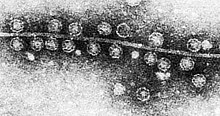Spiegelman's monster
Spiegelman's monsters are short RNA polymers that were created in 1965 in the laboratory of molecular biologist Sol Spiegelman through evolution in an artificial environment from longer natural predecessors (Qβ-RNA). From bacteriophage QB they had inherited and perfected the "ability" by the associated replicase - enzyme to easy replication. The genes for the production of proteins, including the capsid and this replicase, have been lost.
Before the phage genes were lost, the phage RNA amplified in the test tube could be used to allow bacteria to produce whole phages again. The press compared this “act of creation” with the work of Frankenstein . Spiegelman protested against the ascription of having created life from the retort - the natural molecule served as a template. However, he emphasized the importance of the substrate specificity of the phage replicase he had found for chemical evolution - excluding competing substrates through the formation of cells was not absolutely necessary.
Spiegelman and others also used the term “monster” for the degenerate, rapidly replicating RNA in scientific publications.
Discovery and Description
Spiegelman had investigated the problem of how the RNA phage MS2 succeeds in allowing its host cell to reproduce, which contains thousands of times more RNA but does not replicate RNA. After his initial assumption that phages such as retroviruses insert their genetic material into that of the host as DNA, he was able to identify a specific replicase in a binding study , which turned out to be the gene product of MS2. The initial question answered their preferred connection to their genetic makeup. Soon afterwards he also found the specific replicase for the phage Qβ. Both phages belong to the Leviviridae family, which contain positive single-stranded RNA as genetic material, and attack Escherichia coli .
To show that the replicated RNA is infectious , he first added Qβ-RNA to a solution with RNA monomers and Qβ replicase, part of the product in fresh solution, etc. After 15 steps, he could be sure that nothing was from the original there was more left, the product still proved to be infectious (for protoplasts ).
As he continued the process, copy errors kept occurring. But since there was no evolutionary pressure for pathogenicity in the artificial environment, the mutants survived. Grossly incomplete RNA chains that could still be recognized and copied by the replicase even had the advantage of being copied more quickly. Spiegelman gradually reduced the duration of the reaction and thus increased the pressure in the direction of shorter chains. After 74 generations, the 4217 nucleotide long original had become a 218 nucleotide short monster that had lost all genes but was replicated very quickly. Spiegelman had found a form of Darwinian evolution that acted directly on the genome instead of on the phenotype .
Spontaneous emergence
Ten years after Spiegelman's original discovery, it was shown in Manfred Eigen's laboratory that Spiegelman's monsters can even arise spontaneously from a mixture of RNA monomers and Qβ replicase.
A change in the chemical environment, such as different replicase concentrations, the addition of short RNA oligonucleotides , or the presence of an organic chemical molecule that can interact with the RNA, causes a change in the resulting RNA molecules. This makes it possible to create Spiegelman monsters that are chemically dependent on a simple molecule, for example the RNA intercalator acridine orange , without whose presence they cannot multiply.
literature
- Paul Davies : The Fifth Miracle: The Search for the Origin and Meaning of Life . Simon and Schuster, March 16, 2000, ISBN 978-0-684-86309-2 .
- Manfred Eigen : From Strange Simplicity to Complex Familiarity: A Treatise on Matter, Information, Life and Thought . OUP Oxford, May 23, 2013, ISBN 978-0-19-163307-2 .
Web links
Individual evidence
- ^ DR Mills, RL Peterson, S. Spiegelman: An extracellular Darwinian experiment with a self-duplicating nucleic acid molecule. In: Proceedings of the National Academy of Sciences . Volume 58, Number 1, July 1967, ISSN 0027-8424 , pp. 217-224, PMID 5231602 , PMC 335620 (free full text).
- ↑ US National Library of Medicine .
- ↑ JA Lesnaw and ME Reichmann: Identity of the 5'-Terminal RNA Nucleotide Sequence of the Satellite Tobacco Necrosis Virus and Its Helper Virus: Possible Role of the 5'-Terminus in the Recognition by Virus-Specific RNA Replicase . Proceedings of the National Academy of Sciences 66, 1970, pp. 140-145 ( PDF ).
- ^ Andrew MQ King et al .: Virus Taxonomy: Classification and Nomenclature of Viruses . Academic Press, 2012, ISBN 978-0-12-384684-6 , limited preview in Google Book Search.
- ^ S. Spiegelman, I. Haruna, IB Holland, G. Beaudreau, D. Mills: The synthesis of a self-propagating and infectious nucleic acid with a purified enzyme. In: Proceedings of the National Academy of Sciences . Volume 54, Number 3, September 1965, ISSN 0027-8424 , pp. 919-927, PMID 5217468 , PMC 219765 (free full text).
- ↑ DL Kacian, DR Mills, FR Kramer, S. Spiegelman: A replicating RNA molecule suitable for a detailed analysis of extracellular evolution and replication. In: Proceedings of the National Academy of Sciences . Volume 69, Number 10, October 1972, ISSN 0027-8424 , pp. 3038-3042, PMID 4507621 , PMC 389702 (free full text).
- ↑ F. Oehlenschläger, M. Eigen: 30 years later - a new approach to Sol Spiegelman's and Leslie Orgel's in vitro evolutionary studies. Dedicated to Leslie Orgel on the occasion of his 70th birthday. In: Origins of life and evolution of the biosphere: the journal of the International Society for the Study of the Origin of Life. Volume 27, Numbers 5-6, December 1997, pp. 437-457, PMID 9394469 .
- ↑ M. Sumper, R. Luce: Evidence for de novo production of self-replicating and environmentally adapted RNA structures by bacteriophage Qbeta replicase. In: Proceedings of the National Academy of Sciences . Volume 72, Number 1, January 1975, pp. 162-166, PMID 1054493 , PMC 432262 (free full text).


